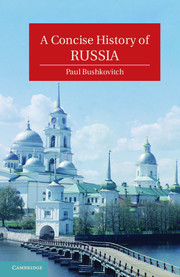Book contents
- Frontmatter
- Contents
- List of Figures
- Abbreviations
- Acknowledgments
- Prologue
- 1 Russia before Russia
- 2 Moscow, Novgorod, Lithuania, and the Mongols
- 3 The Emergence of Russia
- 4 Consolidation and Revolt
- 5 Peter the Great
- 6 Two Empresses
- 7 Catherine the Great
- 8 Russia in the Age of Revolution
- 9 The Pinnacle of Autocracy
- 10 Culture and Autocracy
- 11 The Era of the Great Reforms
- 12 From Serfdom to Nascent Capitalism
- 13 The Golden Age of Russian Culture
- 14 Russia as an Empire
- 15 Autocracy in Decline
- 16 War and Revolution
- 17 Compromise and Preparation
- 18 Revolutions in Russian Culture
- 19 Building Utopia
- 20 War
- 21 Growth, Consolidation, and Stagnation
- 22 Soviet Culture
- 23 The Cold War
- Epilogue
- Further Reading
- Index
9 - The Pinnacle of Autocracy
Published online by Cambridge University Press: 05 June 2012
- Frontmatter
- Contents
- List of Figures
- Abbreviations
- Acknowledgments
- Prologue
- 1 Russia before Russia
- 2 Moscow, Novgorod, Lithuania, and the Mongols
- 3 The Emergence of Russia
- 4 Consolidation and Revolt
- 5 Peter the Great
- 6 Two Empresses
- 7 Catherine the Great
- 8 Russia in the Age of Revolution
- 9 The Pinnacle of Autocracy
- 10 Culture and Autocracy
- 11 The Era of the Great Reforms
- 12 From Serfdom to Nascent Capitalism
- 13 The Golden Age of Russian Culture
- 14 Russia as an Empire
- 15 Autocracy in Decline
- 16 War and Revolution
- 17 Compromise and Preparation
- 18 Revolutions in Russian Culture
- 19 Building Utopia
- 20 War
- 21 Growth, Consolidation, and Stagnation
- 22 Soviet Culture
- 23 The Cold War
- Epilogue
- Further Reading
- Index
Summary
The first acts of the new reign were the capture, investigation, and trials of the Decembrists, as they were known immediately and for ever after. Several hundred officers and men of the rebel regiments, as well as a few civilians, were immediately arrested. Tsar Nicholas appointed a court of numerous officials and high officers, the most distinguished being Michael Speranskii, who had returned from exile and was now again in favor. The investigation was long and detailed, conducted in secret, and eventually ended in the execution of five of the rebels, including Pestel’ and the poet Ryleev, for the crime of plotting against the life of the tsar. Thirty-one others were sentenced to death as well for the same crime, but Nicholas decided to ignore their obvious guilt and commuted the sentences to labor and exile in Siberia. All together one hundred twenty-one of the rebels made the long journey east. Another four hundred fifty were either released without punishment or demoted and transferred to line regiments in the Caucasus.
In Russian history the punishment of the Decembrists became a classic example of official cruelty, but the most striking aspect of their treatment was its lenience. The number of death sentences was about the same as in the reprisals for the Italian constitutionalist revolts of 1820–21 and far less than for similar actions in Spain. Nicholas chose to hold back, perhaps because he still held a very old-fashioned conception of the tsar as the stern father of his people. In any case the Decembrists in Siberia had various fates. Eight of the most “guilty” actually worked in an open-pit silver mine for several months, while others had lighter tasks. The labor sentences were lightened by the 1830s. A number of the Decembrists’ wives were allowed to join them, and as the years passed the labor sentences were entirely commuted to simple prison and eventually exile (outside of prison). Many of the former rebels were given positions in the local administration. In Siberian towns the Decembrists and their wives provided the first glimpse of European culture, for they set up schools and orphanages, put on amateur theatricals, and became the centers of local society. What they were not allowed to do is publish anything or even to return to European Russia. A blanket of silence descended around them, to remain until the death of Nicholas thirty years later.
- Type
- Chapter
- Information
- A Concise History of Russia , pp. 155 - 171Publisher: Cambridge University PressPrint publication year: 2011

